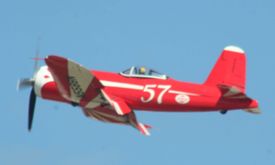PlaneSpottingWorld welcomes all new members! Please gives your ideas at the Terminal.
F2G Corsair
| F2G "Super" Corsair | |
|---|---|
| F2G-1 "Super" Corsair #88458, painted as Race #57, owned by Bob Odergaard of Kindred, North Dakota, flying at the 2005 AirVenture at Oshkosh, Wisconsin. | |
| Type | Carrier-based fighter aircraft |
| Manufacturer | Chance Vought |
| Designed by | Rex Beisel |
| Maiden flight | 15 July 1945 |
| Introduced | 1945 |
| Retired | 1945 |
| Primary users | United States Navy Numerous air racers |
| Number built | 10 |
| Developed from | F4U Corsair |
The Goodyear F2G "Super" Corsair was a development by the Goodyear Aircraft Company of the FG-1/F4U-1 Corsair design as a special low-altitude version of a fighter equipped with a Pratt & Whitney R-4360 twenty-eight cylinder, four row radial air-cooled engine. Although often cited that the origin of the aircraft was as an interceptor of low-flying Japanese suicide airplanes, its actual beginnings came about in 1939 when the Pratt and Whitney company first proposed its enormous new engine. The F2G lineage was tied to its engine design rather than tactical requirements. [1]
Design and development
Using experience from building the fixed-wing FG-1, a version of the folding wing F4U-1 Corsair, in early 1944, Goodyear extensively modified a standard FG-1 airframe, designated the XF2G-1, to take advantage of the 50% increase in take-off power provided by the R-4360 engine. In addition, an all-round vision bubble-type canopy was installed. In March 1944, Goodyear was awarded a contract to deliver 418 F2G-1 and 10 F2G-2 aircraft. The F2G-2 version included modifications for carrier operations.
Armament provisions included alternative wing-mounted installations for four or six 0.5 inch (12.7 mm) machine guns and eight 5 inch (127 mm) rockets or two 1,000 or 1,600 lb (450 or 725 kg) bombs. The internal fuel capacity was increased greatly over that of the FG-1, and provisions were provided to carry two droppable external tanks.
By the end of the war in August 1945, only five each of the F2G-1 and F2G-2 aircraft were completed. Testing, also, revealed deficiencies in lateral control and insufficient speed that were bars to further development of the aircraft and, thus, further production of the fighters was canceled.
Racing
Only three of the "Super Corsairs" are still in existence. F2G-1 BuNo 88454 is currently on display in standard Navy markings at the Champlin Fighter Museum. The fifth F2G-1, BuNo 88458, was purchased by Cook Cleland, who went on to finish third in the 1949 Thompson Trophy Race and first in the 1949 Tinnerman Trophy Race. Over time, the plane, registered as NX5588N, went from owner to owner and slowly deteriorated. Finally in 1996, NX5588N was purchased by Bob Odegaard of North Dakota, and was returned to airworthy condition in 1999. Odegaard is currently restoring F2G-2 BuNo 88463, also of air racing fame, for a static display.
Specifications (F2G-2)
General characteristics
- Crew: 1
- Length: 33 ft 9 in (10.3 m)
- Wingspan: 41 ft (12.5 m)
- Height: 16 ft 1 in (4.9 m)
- Wing area: 314 ft² (29 m²)
- Empty weight: 10,249 lb (4,649 kg)
- Loaded weight: 13,346 lb (6,054 kg)
- Max takeoff weight: 15,422 lb (6,995 kg)
- Powerplant: 1× Pratt & Whitney R-4360-4 "Wasp Major" 28-cylinder radial engine, 3,000 hp (2,200 kW)
Performance
- Maximum speed: 431 mph (374 knots, 694 km/h) at 16,400 ft (5,000 m)
- Range: 1,955 mi (1,699 nm, 3,146 km) with external tanks
- Service ceiling: 38,800 ft (11,800 m)
- Rate of climb: 7,000 ft/min (35.6 m/s)
- Wing loading: 42.5 lb/ft² (208 kg/m²)
- Power/mass: 0.22 hp/lb (370 W/kg)
Armament
- Guns: 4× .50 caliber (12.7 mm) M2 Browning machine guns, 400 rounds/gun
- Rockets: 8× 5 in (127 mm) rockets or
- Bombs: 1,600 lb (725 kg)
References
- ↑ Pautigny 2003, p.76.
- Green, William. War Planes of the Second World War - Fighters (Vol. 4). New York: MacDonald and Company, 1961.
- Lockett, Brian. Corsairs with Four-bank Radials. "Goleta Air and Space Museum." [1] Access date: 16 January 2007.
- Pautigny, Bruno (traslated from the French by Alan McKay). Corsair: 30 Years of Filibustering 1940-1970. Paris: Histoire & Collections, 2003. ISBN 2-913903-28-2.
- Racing Corsairs. Society of Air Racing Historians. [2] Access date: 16 January 2007.
Related content
Related development
Designation sequence
- FG - F2G
Related lists
Lists relating to aviation | |
|---|---|
| General | Timeline of aviation · Aircraft · Aircraft manufacturers · Aircraft engines · Aircraft engine manufacturers · Airports · Airlines |
| Military | Air forces · Aircraft weapons · Missiles · Unmanned aerial vehicles (UAVs) · Experimental aircraft |
| Notable incidents and accidents | Military aviation · Airliners · General aviation · Famous aviation-related deaths |
| Records | Flight airspeed record · Flight distance record · Flight altitude record · Flight endurance record · Most produced aircraft |

